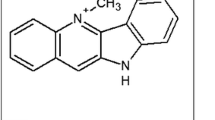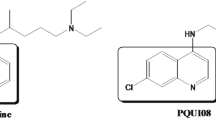Abstract
Many malaria-endemic areas are also associated with high rates of human immunodeficiency virus (HIV) infection. An understanding of the chemotherapeutic interactions that occur during malaria and HIV co-infections is important. Our previous studies have demonstrated that some antiretroviral protease inhibitors are effective in inhibiting Plasmodium falciparum growth in vitro. Currently, studies examining the interactions between antiretroviral protease inhibitors and antimalarial drugs are being conducted, but the data are limited. In this study, we examined the synergistic interactions between the antiretroviral protease inhibitor indinavir and chloroquine (CQ) in chloroquine-resistant and chloroquine-sensitive malaria parasites in vitro and in vivo. In vitro, by using modified fixed-ratio isobologram method, fractional inhibitory concentrations index (FICI) was calculated to indicate the interaction between the two drugs. The results demonstrated that indinavir interacted synergistically with chloroquine against both chloroquine-sensitive P. falciparum clone 3D7 (mean FICI 0.784) and multidrug-resistant P. falciparum clone Dd2 (mean FICI 0.599). In vivo drug interactions were measured using a 4-day suppressive test in a rodent malaria model infected with Plasmodium chabaudi. We observed that indinavir enhanced the antimalarial activity of chloroquine against both the chloroquine-sensitive line P. chabaudi ASS and the chloroquine-resistant line P. chabaudi ASCQ. More importantly, chloroquine had a 100% clearance of asexual parasites when used in combination with indinavir at an appropriate dose ratio (10 mg/kg CQ + 1.8 g/kg indinavir) where there was no obvious toxicity. We conclude from this study that the combination of indinavir and chloroquine may become a novel antimalarial drug regimen.



Similar content being viewed by others
References
Andrews KT, Fairlie DP, Madala PK, Ray J, Wyatt DM, Hilton PM, Melville LA, Beattie L, Gardiner DL, Reid C, Stoermer MJ, Skinner-Adams T, Berry C, McCarthy JS (2006) Potencies of human immunodeficiency virus protease inhibitors in vitro against Plasmodium falciparum and in vivo against murine malaria. Antimicrob Agents Chemother 50:639–648
Bin Dajem SM, Al-Sheikh AA, Bohol MF, Alhawi M, Al-Ahdal MN, Al-Qahtani A (2011) Detecting mutations in PfCRT and PfMDR1 genes among Plasmodium falciparum isolates from Saudi Arabia by pyrosequencing. Parasitol Res. doi:10.1007/s00436-011-2251-5
Canfield CJ, Pudney M, Gutteridge WE (1995) Interactions of atovaquone with other antimalarial drugs against Plasmodium falciparum in vitro. Exp Parasitol 80:373–381
Chenniappan K, Kadarkarai M (2010) In vitro antimalarial activity of traditionally used Western Ghats plants from India and their interactions with chloroquine against chloroquine-resistant Plasmodium falciparum. Parasitol Res 107:1351–1364
Deloron P, Basco LK, Dubois B, Gaudin C, Clavier F, Le Bras J, Verdier F (1991) In vitro and in vivo potentiation of chloroquine against malaria parasites by an enantiomer of amlodipine. Antimicrob Agents Chemother 35:1338–1342
Fidock DA, Rosenthal PJ, Croft SL, Brun R, Nwaka S (2004) Antimalarial drug discovery: efficacy models for compound screening. Nat Rev Drug Discov 3:509–520
Fivelman QL, Adagu IS, Warhurst DC (2004) Modified fixed-ratio isobologram method for studying in vitro interactions between atovaquone and proguanil or dihydroartemisinin against drug-resistant strains of Plasmodium falciparum. Antimicrob Agents Chemother 48:4097–4102
He Z, Qin L, Chen L, Peng N, You J, Chen X (2008) Synergy of human immunodeficiency virus protease inhibitors with chloroquine against Plasmodium falciparum in vitro and Plasmodium chabaudi in vivo. Antimicrob Agents Chemother 52:2653–2656
He Z, Chen L, You J, Qin L, Chen X (2009) Antiretroviral protease inhibitors potentiate chloroquine antimalarial activity in malaria parasites by regulating intracellular glutathione metabolism. Exp Parasitol 123:122–127
He Z, Chen L, You J, Qin L, Chen X (2010) In vitro interactions between antiretroviral protease inhibitors and artemisinin endoperoxides against Plasmodium falciparum. Int J Antimicrob Agents 35:191–193
Hunt P, Cravo PV, Donleavy P, Carlton JM, Walliker D (2004) Chloroquine resistance in Plasmodium chabaudi: are chloroquine-resistance transporter (crt) and multi-drug resistance (mdr1) orthologues involved? Mol Biochem Parasitol 133:27–35
Kelly JX, Smilkstein MJ, Brun R, Wittlin S, Cooper RA, Lane KD, Janowsky A, Johnson RA, Dodean RA, Winter R, Hinrichs DJ, Riscoe MK (2009) Discovery of dual function acridones as a new antimalarial chemotype. Nature 459:270–273
Lambros C, Vanderberg JP (1979) Synchronization of Plasmodium falciparum erythrocytic stages in culture. J Parasitol 65:418–420
Liu J, Gluzman IY, Drew ME, Goldberg DE (2005) The role of Plasmodium falciparum food vacuole plasmepsins. J Biol Chem 280:1432–1437
Martin RE, Marchetti RV, Cowan AI, Howitt SM, Broer S, Kirk K (2009) Chloroquine transport via the malaria parasite's chloroquine resistance transporter. Science 325:1680–1682
Mungthin M, Suwandittakul N, Chaijaroenkul W, Rungsrihirunrat K, Harnyuttanakorn P, Seugorn A, Na Bangchang K (2010) The patterns of mutation and amplification of Plasmodium falciparum pfcrt and pfmdr1 genes in Thailand during the year 1988 to 2003. Parasitol Res 107:539–545
Omara-Opyene AL, Moura PA, Sulsona CR, Bonilla JA, Yowell CA, Fujioka H, Fidock DA, Dame JB (2004) Genetic disruption of the Plasmodium falciparum digestive vacuole plasmepsins demonstrates their functional redundancy. J Biol Chem 279:54088–54096
Parikh S, Gut J, Istvan E, Goldberg DE, Havlir DV, Rosenthal PJ (2005) Antimalarial activity of human immunodeficiency virus type 1 protease inhibitors. Antimicrob Agents Chemother 49:2983–2985
Ravikumar S, Jacob Inbaneson S, Suganthi P, Gokulakrishnan R, Venkatesan M (2010) In vitro antiplasmodial activity of ethanolic extracts of seaweed macroalgae against Plasmodium falciparum. Parasitol Res. doi:10.1007/s00436-010-2185-3
Ridley RG (2002) Medical need, scientific opportunity and the drive for antimalarial drugs. Nature 415:686–693
Savarino A, Lucia MB, Rastrelli E, Rutella S, Golotta C, Morra E, Tamburrini E, Perno CF, Boelaert JR, Sperber K, Cauda R (2004) Anti-HIV effects of chloroquine: inhibition of viral particle glycosylation and synergism with protease inhibitors. J Acquir Immune Defic Syndr 35:223–232
Sidhu AB, Verdier-Pinard D, Fidock DA (2002) Chloroquine resistance in Plasmodium falciparum malaria parasites conferred by pfcrt mutations. Science 298:210–213
Skinner-Adams TS, McCarthy JS, Gardiner DL, Hilton PM, Andrews KT (2004) Antiretrovirals as antimalarial agents. J Infect Dis 190:1998–2000
Skinner-Adams TS, Andrews KT, Melville L, McCarthy J, Gardiner DL (2007) Synergistic interactions of the antiretroviral protease inhibitors saquinavir and ritonavir with chloroquine and mefloquine against Plasmodium falciparum in vitro. Antimicrob Agents Chemother 51:759–762
Snow RW, Craig M, Deichmann U, Marsh K (1999) Estimating mortality, morbidity and disability due to malaria among Africa's non-pregnant population. Bull World Health Organ 77:624–640
Trager W, Jensen JB (1976) Human malaria parasites in continuous culture. Science 193:673–675
Vessière A, Berry A, Fabre R, Benoit-Vical F, Magnaval JF (2004) Detection by real-time PCR of the Pfcrt T76 mutation, a molecular marker of chloroquine-resistant Plasmodium falciparum strains. Parasitol Res 93:5–7
Ward SA, Bray PG (2001) Is reversal of chloroquine resistance ready for the clinic? Lancet 357:904
Acknowledgements
This work was supported by the Knowledge Innovation Program of the Chinese Academy of Sciences (Grant No. KSCX2-EW-J-27).
Author information
Authors and Affiliations
Corresponding author
Rights and permissions
About this article
Cite this article
Li, X., He, Z., Chen, L. et al. Synergy of the antiretroviral protease inhibitor indinavir and chloroquine against malaria parasites in vitro and in vivo. Parasitol Res 109, 1519–1524 (2011). https://doi.org/10.1007/s00436-011-2427-z
Received:
Accepted:
Published:
Issue Date:
DOI: https://doi.org/10.1007/s00436-011-2427-z




